A two-day in person poll of 1,004 students conducted by The University Times in campus and off-campus locations predicts that Kevin Keane is likely to be elected President of Trinity College Dublin Students’ Union (TCDSU) on the second count.
Laura Grady also looks likely to be elected Welfare Officer, with none of the four uncontested candidate at risk of losing to Re-Open Nominations (RON).
President
Our polls predict that final-year law student Kevin Keane is to be elected as the President of TCDSU on the second count.
Kevin Keane ahead on the first count
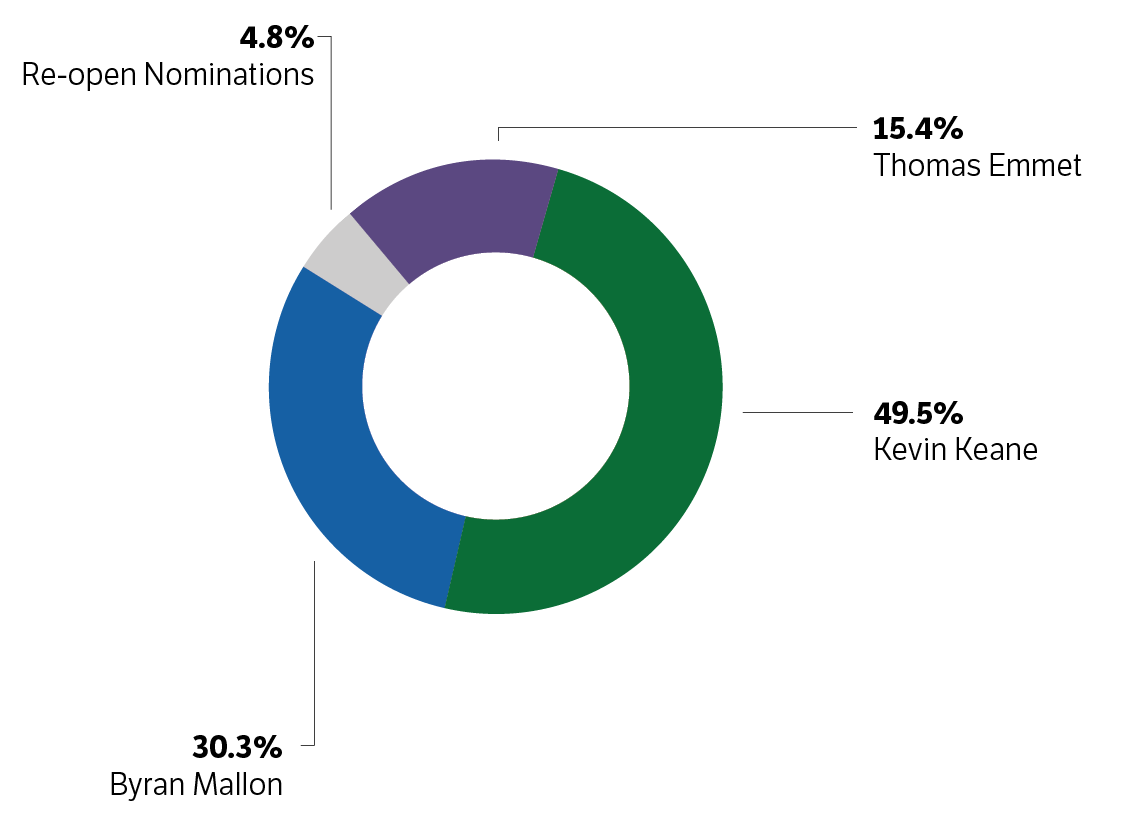
First preference votes see 49.5 per cent of students supporting Kevin Keane, 15.3 per cent for Thomas Emmet and Bryan Mallon receives 30.3 per cent. Our polls predict that the remainder of the electorate, 4.8 per cent, are likely to ask the union to re-open nominations but this request will be eliminated on the first count.
Keane is expected to win on the second count with 52.2 per cent of the vote. Emmet will with 16.3 per cent of the vote while Mallon will exit the race with 31.5 per cent of the vote.
Keane likely elected on the second count
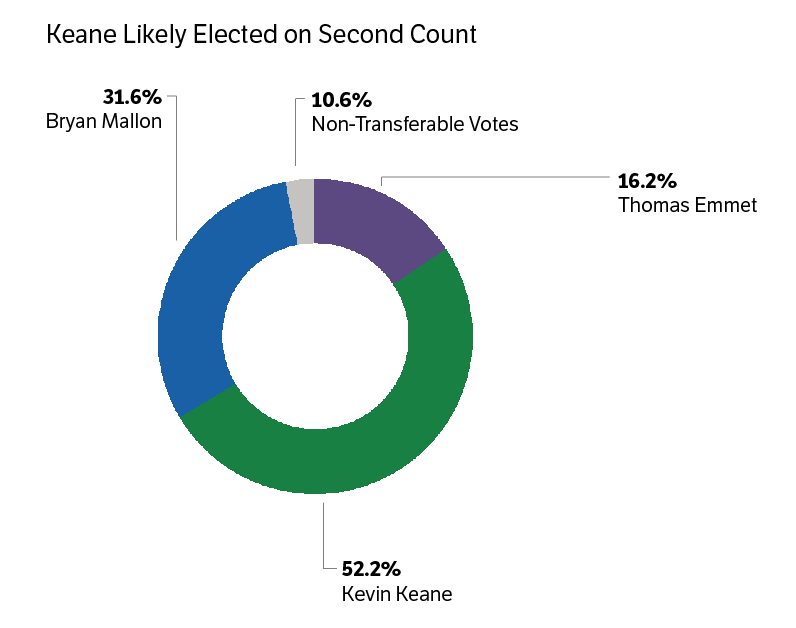
The faculty breakdown shows Arts, Humanities and Social Science (AHSS) students favour Keane ahead of Mallon and Emmet, as he receives 51.8 per cent of the electorates’ vote. This is unsurprising as, by studying law, Keane’s peers are located predominantly within AHSS. Also, when, during last week, a printing error caused a delay in the candidates receiving their manifestos, Keane’s team showed particular creativity in hanging t-shirts on the walls of the Arts Block. Emmet had half the amount of manifestos than the other candidates as he opted to print his on 100 percent recycled paper, which cost more than regular manifesto paper. Mallon and Emmet receive 28.6 per cent and 15.6 per cent of the AHSS vote, respectively. Most of Emmet’s votes will come from Engineering, Mathematics and Science (EMS) students, where he will pick up 18 per cent of their vote. However, once again Keane will take the majority of EMS vote with 42 per cent. Votes for Mallon account for 32 per cent of their overall vote. Health Science students seem to favour Keane as he is expected to pick up 52.8 per cent of the vote. Mallon also seems to have a strong backing from Health Science students as he will pick up his highest percentage vote from the HS faculty obtaining 36.1 per cent. This is most likely due to their emphasis on visits to St James’s and D’Olier St, particularly on Friday when they both lost an hour of canvassing in the Arts Block and the Hamilton. They chose instead to focus on off-campus locations. Emmet struggles for votes amongst HS students as he only manages to secure 8.3 per cent of their vote.
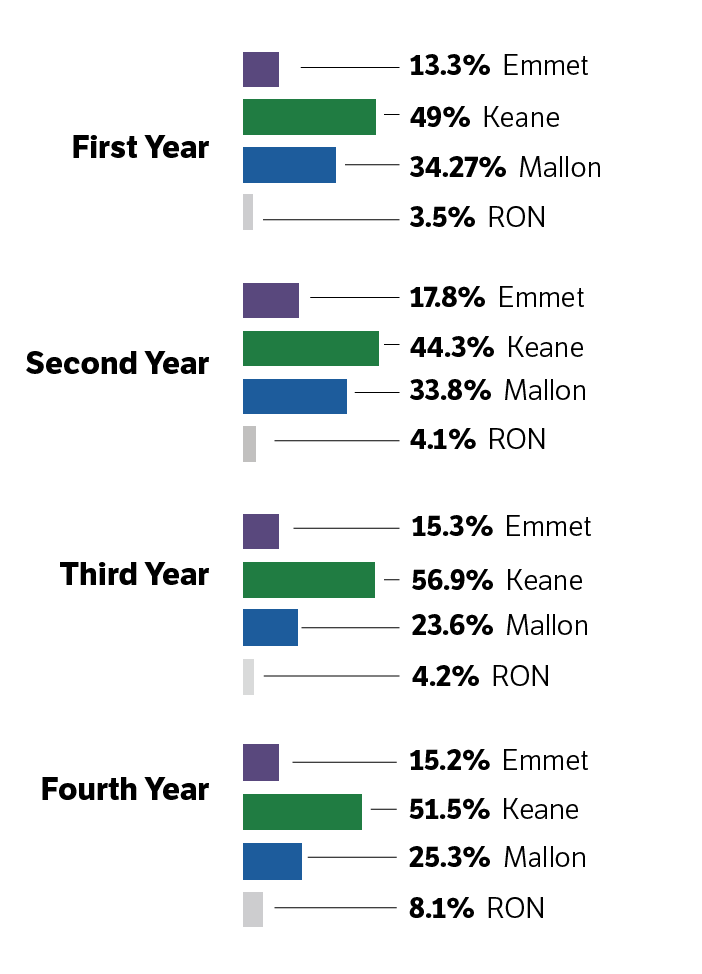
Votes to re-open nominations in the presidential race have quite an uneven distribution among the three faculties. A large number of students in EMS believe nominations should be re-opened with 8 per cent of them voting accordingly. However, health science students seem more satisfied with candidate choice, with only 2.8 per cent of them voting to re-open nominations, while 4 per cent of AHSS students believe that nominations should be reopened.
Broken down into year groups, it is evident that first years favour Keane ahead of Emmet and Mallon. Keane will receive 48.9 per cent of the first year vote. This is not surprising due to the strong campaign that Keane is running. His green campaign is highly visible on the ground and although the morphsuits are a little unnerving they attract the attention of first years who have yet to experience a TCDSU election. They also offered some humour to an otherwise compressed election period and contentious presidential race. Despite Keane leading Mallon amongst first years, Mallon will receive his highest percentage of vote from a year from the first year cohort. This could be attributed to his platform of accessibility and a hopeful ideal of Trinity being a college for people of all socioeconomic backgrounds, something which has the power to strike first year students most forcefully. Keane will also receive 44.3 per cent of the vote from second years. This is quite a large margin ahead of the 33.8 per cent Mallon will receive and 17.8 per cent Emmet will receive.
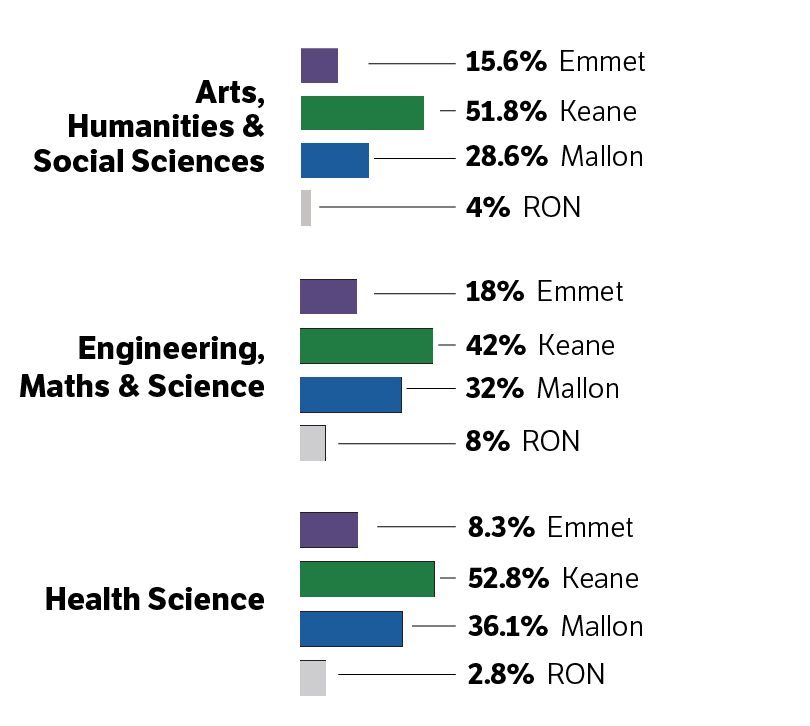
Keane is most popular amongst third years also, where he will receive his highest proportion of votes from any year with 56.9 per cent. Conversely, with 23.6 per cent of the third year vote, here Mallon will receive his lowest proportion of votes from any year. Emmet will also struggle for votes from third years as he manages only 15.3 per cent of their vote. Finally, final year students also opt strongly for Keane. Keane will receive 51.5 per cent of the final year vote, whereas Mallon and Emmet will only receive 25.2 and 15.2 per cent of their vote respectively. That all three presidential candidates are in their final year of college means that they do not benefit from the support of their peers in the same way they might have if their year of study varied. Support for Keane among his own cohort is double that of Mallon and nearly triple that of Emmet.
Similar to faculties, the uneven distribution of votes to re-open nominations is also evident across the four years. With 8.1 per cent of their vote, fourth year students in particular have voted quite strongly for a re-opening of nominations. As we go down the years, votes to re-open nominations decreases, however, with 4.2 per cent of third years and 4.1 per cent of second year voting to re-open nominations. Finally, the proportion of first year votes to re-open nominations is the least of the four years at 3.5 per cent.
While Keane’s lead over Mallon and Emmet is considerable and stable, there is potential for the latter two to pull ahead. The University Times prediction models always exclude undecided voters – of which there were around 38.3 per cent – and take into account that such voters normally split marginally in favour of the leading candidate. That said, with a reduced election period and voting beginning today, it would take a near flawlessly executed and creative campaign to overtake Keane’s lead.
Education
Alice MacPherson looks set to be elected without issue in the uncontested education race. MacPherson, a final-year history and english student, should take the role of education officer with 87.9 per cent of the vote, according to a two-day poll of 1,005 students conducted by The University Times. With the highest predicted percentage of re-open nominations, it would appear that MacPherson is less favourable to voters than the other uncontested candidates.
The poll conducted by The University Times last week suggests that 40 per cent of the electorate did not know whether they would choose MacPherson or to re-open nominations. Although MacPherson has received more re-open nominations, she has also received the highest percentage of uncertainty, which is 10 per cent larger than another uncontested candidate, Dominic McGrath, about whom 30 per cent of voters are undecided.
Alice MacPherson Takes on RON
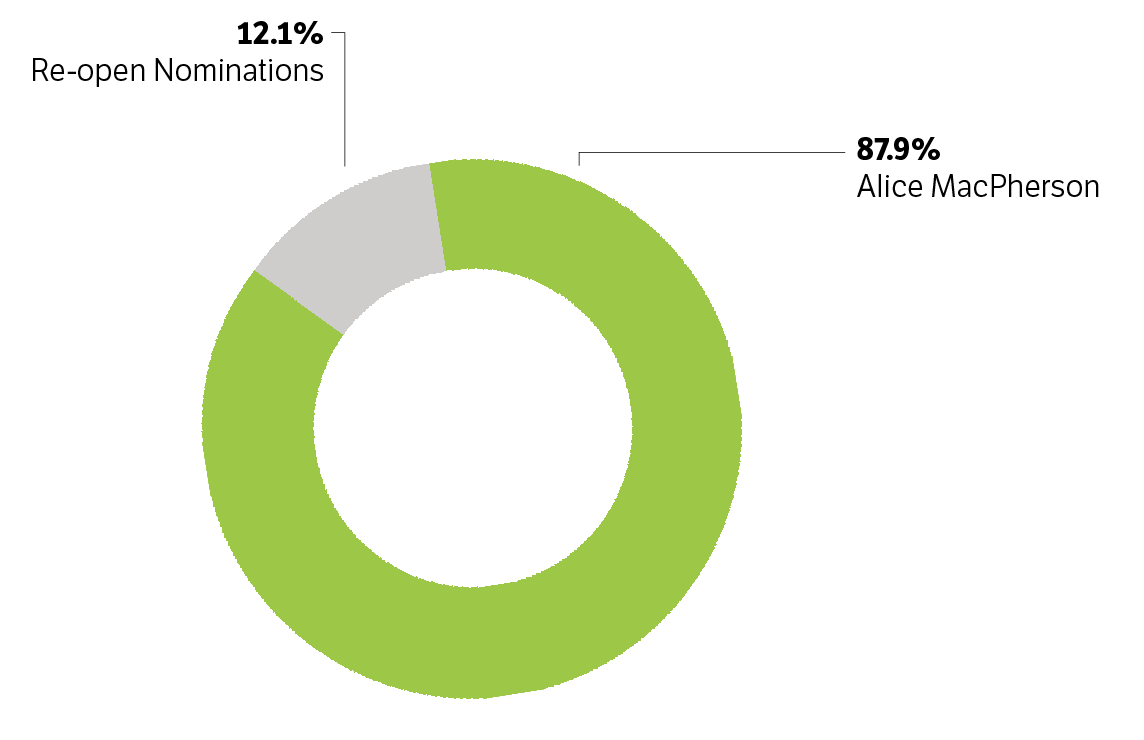
MacPherson performed well during the hustings that took place over the first week of campaigning. She made an impression by being well-versed on issues that fall under the remit of the education officer. When asked about the student partnership proposal on Thursday’s Equality and Diversity hustings, MacPherson held her ground and was much more prepared than all three of the presidential candidates, who were obviously lacking knowledge on the topic. As this proposal has been spearheaded by current Education Officer, Dale Whelehan, it is not surprising that MacPherson is aware of and well-informed on the issue. It is likely that it is MacPherson’s past and current involvement with the union has made her more conscious of projects such as these, especially compared to the candidates running in the presidential race.
In last year’s education race, Dale Whelehan, was deemed elected on the first count with 2,083 votes or 59.4 per cent of the vote. A poll conducted by The University Times that predicted that Whelehan would be victorious with 65 per cent of the vote was incorrect, but this was perhaps due to Whelehan’s opponent’s, Patrick Higgins, improvement as a candidate over the election period. MacPherson and Whelehan are similar in that they both come from the position of convenors of Arts, Humanities and Social Sciences and Health Science respectively. Molly Kenny, Whelehan’s predecessor, came from the position of Engineering, Maths and Science (EMS) Convenor. That the three have come from the roles of part-time officers for the union does not help the notion that in order to be education officer you do not have to have union experience. This is something that MacPherson herself has promised, over the first week of campaigning, to address, as many others have done before her, making little headway.
MacPherson, sees the most certainty in the health sciences, with 93 per cent of voters choosing her rather than opting to re-open nominations. The engagement of health science students, it can be assumed, will be less this year compared to last year as no candidate comes from the faculty of health science. Last year’s poll saw Whelehan take 83.3 per cent of the vote in health science. Whereas this year, MacPherson, although not as certain in her own faculty of Arts, Humanities and Social Sciences, with 87.3 per cent of the votes, sees most of her support coming from her peers in final year. Final-year students give MacPherson 91.8 per cent of their vote, which is 2.8 points higher than the first-year vote.
Welfare
The welfare race, with five candidates, is the most contested race in this year’s elections. Laura Grady looks set to become the next TCDSU Welfare Officer, with The University Times predicting that Grady will win on the fifth and final count with 57.5 per cent of the vote.
The second-year BESS student will be elected ahead of fourth-year mathematics student, Damien McClean, who will receive 42.5 per cent of the vote on the final count. Grady, who is running on a platform of approachability, engagement and mental health, sees preference in the first count, receiving 29.9 per cent of the vote. Grady is, evidently, a firm favourite from the first count, followed closely by McClean who, with first preference votes, trails Grady by only 6.2 per cent.
Laura Grady Leads on first count
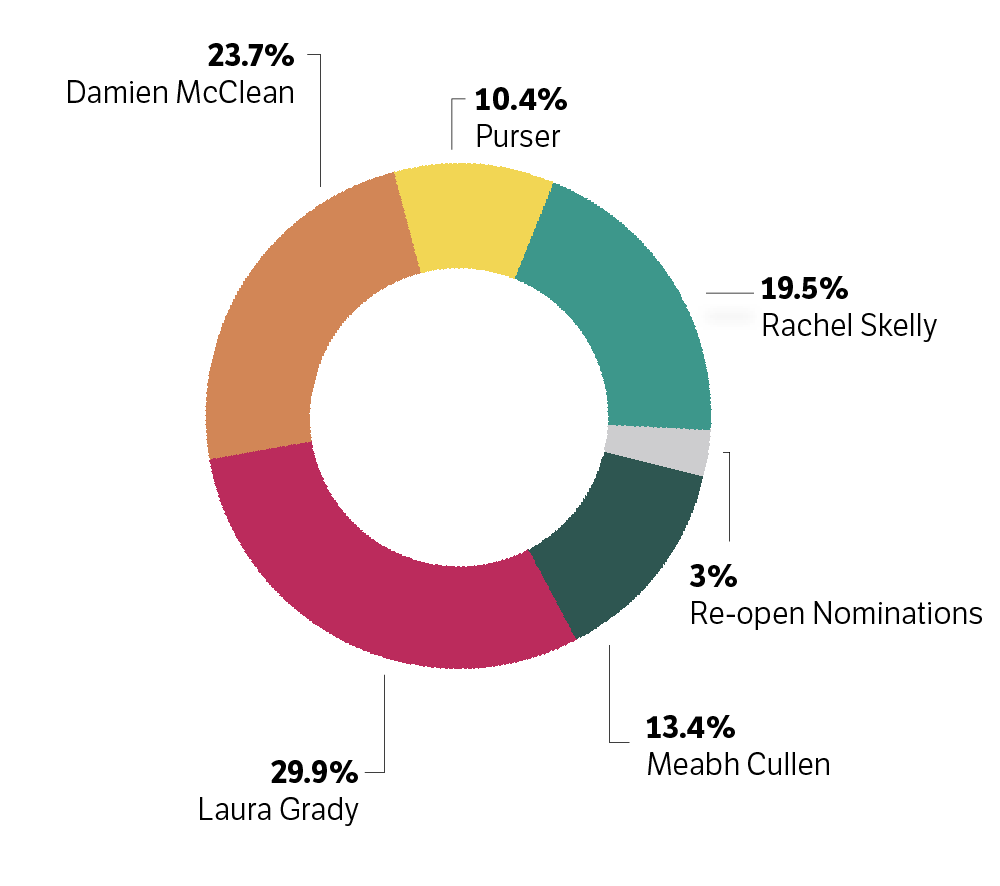
The race to become the next welfare officer for TCDSU is contested but that does not necessarily mean it has been particularly fascinating or insightful. The five candidates ran on similar platforms, with many of them concerning themselves with being approachable and a nice person rather than addressing policy and new initiatives at hustings. This follows the model established by former welfare candidates and officers, many of which trade on the promise of understanding and enduring likeability. Indeed, at numerous times in their campaigns, multiple candidates traded on their personalities. Mental health and consent classes remain at the top of the list of priorities for many of the candidates, although some mistakenly took this year’s classes as mandatory, and they have failed to make a lasting impression upon the electorate with such similar campaigns.
The University Times polls predict that re-open nominations, sitting at three per cent, will be eliminated on the first count. Votes to re-open nominations are at their highest in the faculty of Arts, Humanities and Social Sciences (AHSS), as they are in the uncontested races as well. Health science students appear the most certain in their voting preferences as re-open nominations receives 1.6 per cent of the vote.
Grady likely elected on the fifth count
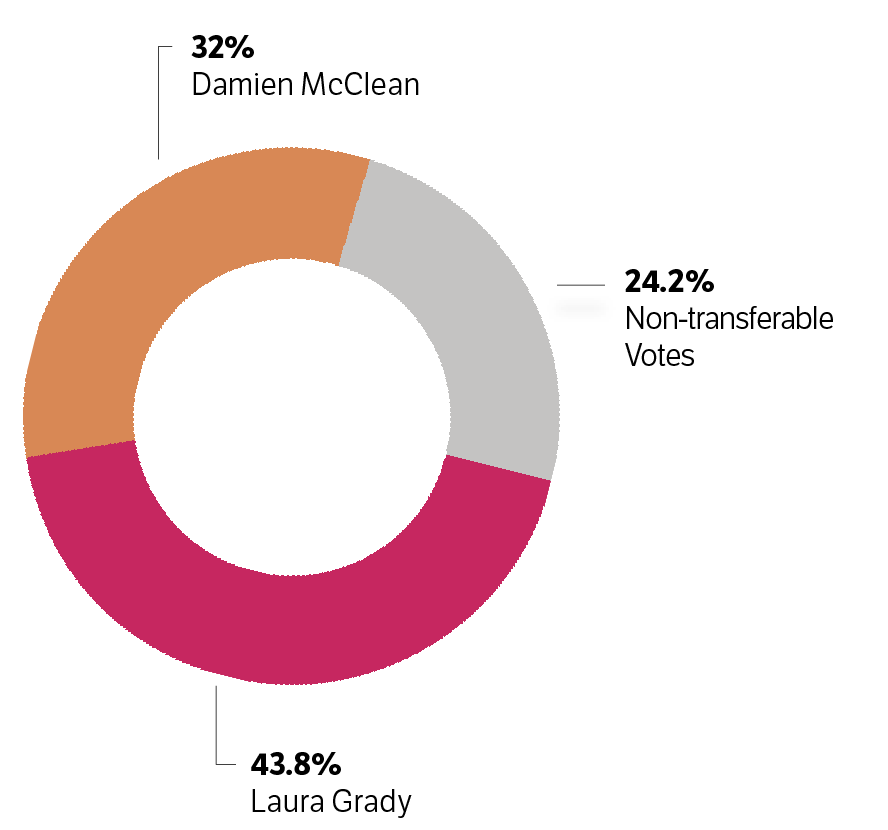
Grady receives most of her support from her own year group, obtaining 37.7 per cent of the vote from her peers in second year. Her campaign, both on the ground and online has been visible but not overwhelming. Grady’s teddy bear picnic and a general emphasis on more playful aspects of life, have drawn intrigue and enabled her to stand out, particularly in an extremely compressed election period. Experience was evidently important in the election of Aoibhinn Loughlin to the position last year. Her two opponents, Éamonn Redmond and Andrew Wafer, failed to make headway against Loughlin’s experience, and she was elected on the first count with 60.3 per cent of the vote. This year, experience is evident in all candidates and they draw from every corner of welfare support in Trinity.
McClean, however, is the preferred candidate among first and final-year students. That he sits higher than Grady in the polls filled by his fellow final-year students is not surprising. However, McClean’s popularity with first years perhaps highlights his obvious enthusiasm and energy that has been evident in his on-the-ground campaign. Rachel Skelly has performed consistently well at hustings, chiming in particularly on the topic that is clearly her forté, consent. At a hustings hosted by The University Times and Trinity News, Skelly was quizzed on whether her “sex-positivity” policies would be alienating to certain students who might not fit into this, and perhaps this was the case. Our polls predict that Skelly will be eliminated on the fourth count, having gained the most support from her fellow third years, with 25.9 per cent of the vote.
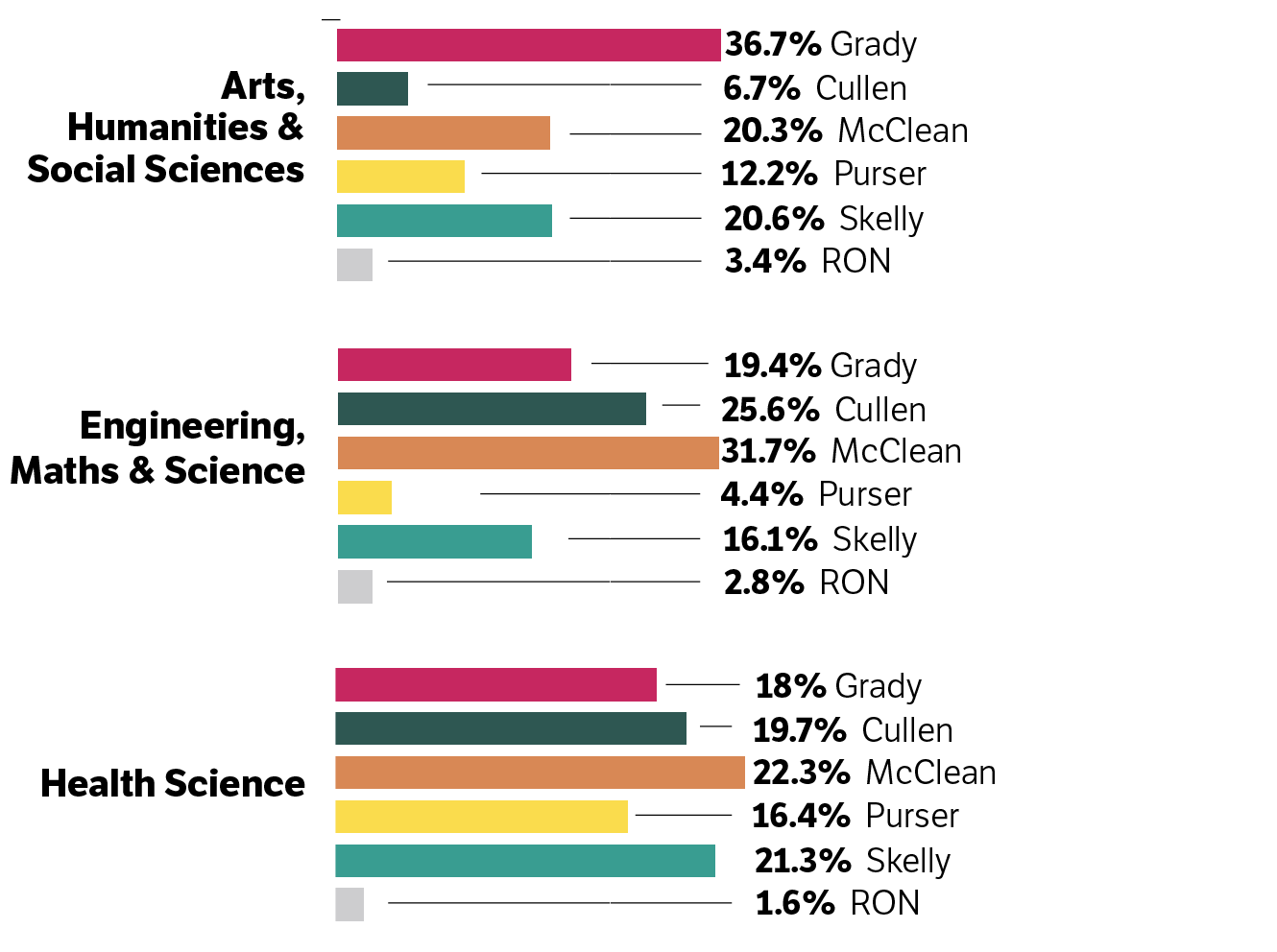
Emma Purser and Meabh Cullen have evidently failed to resonate with the overall voting population. Purser, who looks set to be eliminated on the second count, has been consistent in her promises and policies during hustings, but faced tough questioning at the hustings hosted by The University Times and Trinity News. She did not manage to make an impression even though she gave some impassioned and emotional vouches for the vote. Cullen, our polls predict, will exit the race on the third count having received her highest vote, of 25.6 per cent, from her own faculty of Engineering, Maths and Science (EMS). Although she was particularly strong on issues concerning disabilities, Cullen, generally, did not hold her ground as well as other candidates.
Communications & Marketing
The race to be the communications & marketing officer is usually between two candidates. However, this year we only see one candidate running for the position, Úna Harty, a third-year nanoscience student. It is not surprising that she looks set to receive over 90 per cent of the vote. Harty’s on-the-ground campaign has been visible, but her campaign in general has been more noticeably present online, which, to an extent, is vital for a candidate running for this position. However, the fact that Harty has chosen to visit Trinity Hall for the first time on Sunday night is surprising, as most of the other candidates – even those in uncontested races, bar education – have visited Halls at least once in their first week of campaigning. This strategy would most likely not have worked were the race contested.
As the position is only in its third year, the candidate pattern has yet to become established. Although the previous two years have seen only two candidates running, the races were not particularly tight. The current Communications & Marketing Officer, Glen Byrne, was deemed elected on the first count, with 54.2 per cent of the vote. The previous year, 2015, saw the first ever Communications & Marketing Officer, Aifric Ní Chríodáin, elected to the position with 61.3 per cent of the vote.
No fear of RON for Harty
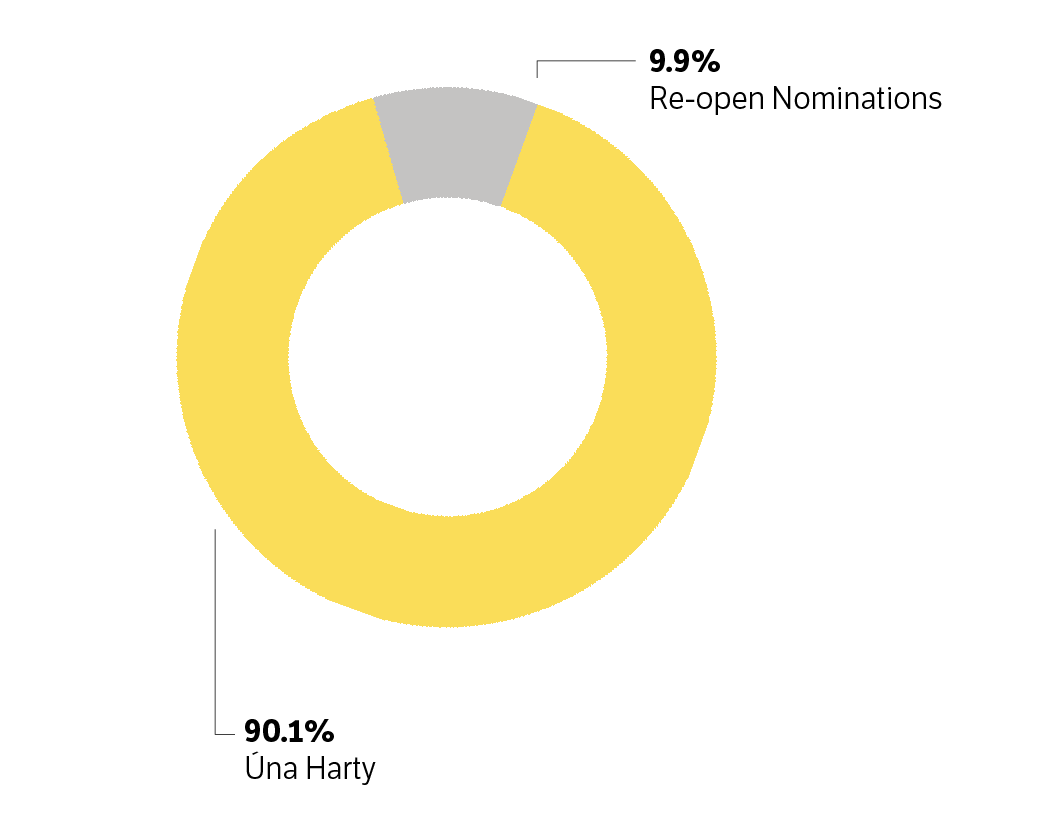
With Harty running uncontested, the number of votes for re-open nominations is significantly higher than what was seen in the previous two elections, sitting at 10 per cent. In 2015, when Ní Chríodáin was elected, re-open nominations sat at 4.2 per cent of the vote. Last year’s election saw a re-open nominations vote of 4.5 per cent for the communications and marketing race.
The data collected by The University Times, gathered during a two-day poll of 1,005 students, demonstrates that the health sciences had the lowest percentage of re-open nominations, as it had with all of the uncontested races. The engagement with off-campus students is evident in the uncontested races, with Harty having visited St James’s on Friday morning. The health sciences look to be the most agreeable with Harty, as re-open nominations only receives 4 per cent of the vote. Arts, Humanities and Social Science (AHSS) students appear to be the hardest to impress. Polls suggest that Harty will receive 88.6 per cent of the vote from the arts end of campus. This is not including the vast amount of students who chose the “do not know” preference, which sees students unsure of who to vote for at 33.8 per cent. AHSS’s voting patterns suggest that there is more of an engagement with the elections and the union in general this year.
Harty’s campaign branding, which lacks familiar Trinity landmarks lurking behind the candidate, is refreshing. Branding and social media presence is something that is particularly important within this race, more so than with the others due to the design-heavy nature of the position. Although her online presence is not overwhelming, it is steady, with regular updates and a campaign video being released on Wednesday night, following the first official day of the elections period. The fact that she is wearing a “Repeal” jumper in the video highlights the importance of branding in campaigns and the recognition of brands in political statements. Harty had faced only one fine as the first week of campaigning came to a close, due to having put more than one poster on a noticeboard.
Entertainments
This year’s race for the position of Entertainments Officer differs greatly from previous years. This sabbatical position has not seen an uncontested race in the lifetime of any student who is currently studying in Trinity. A poll conducted by The University Times shows that Jonah Craig, the sole candidate running to be elected to the position, falls just short of receiving 90 per cent of the overall student vote with the vote for re-open nominations sitting at 10.3 per cent. There is a disparity of only 1 per cent between Craig, Dominic McGrath and Úna Harty, who are running uncontested for the Editor of The University Times and Communications & Marketing Officer respectively.
Craig offers a paradoxical approach to the role compared to current Entertainments Officer, Padraic Rowley, and Rowley’s predecessor, Katie Cogan. Craig has, over the first week of campaigning, demonstrated that he intends to take a measured attitude towards the office and the work of Trinity Ents. Craig’s campaign has been consistent and at times, quite innovative. When the print materials for all candidates were delayed Craig and his team decided to project his manifesto on the wall in the Arts Block. His campaign video, although released late into the campaigns, stood out from the other candidates. Although, his performance at hustings has not been dazzling, Craig has been consistent in his answers and promises, even if they are a little bland at times.
Uncontested Craig remains safe
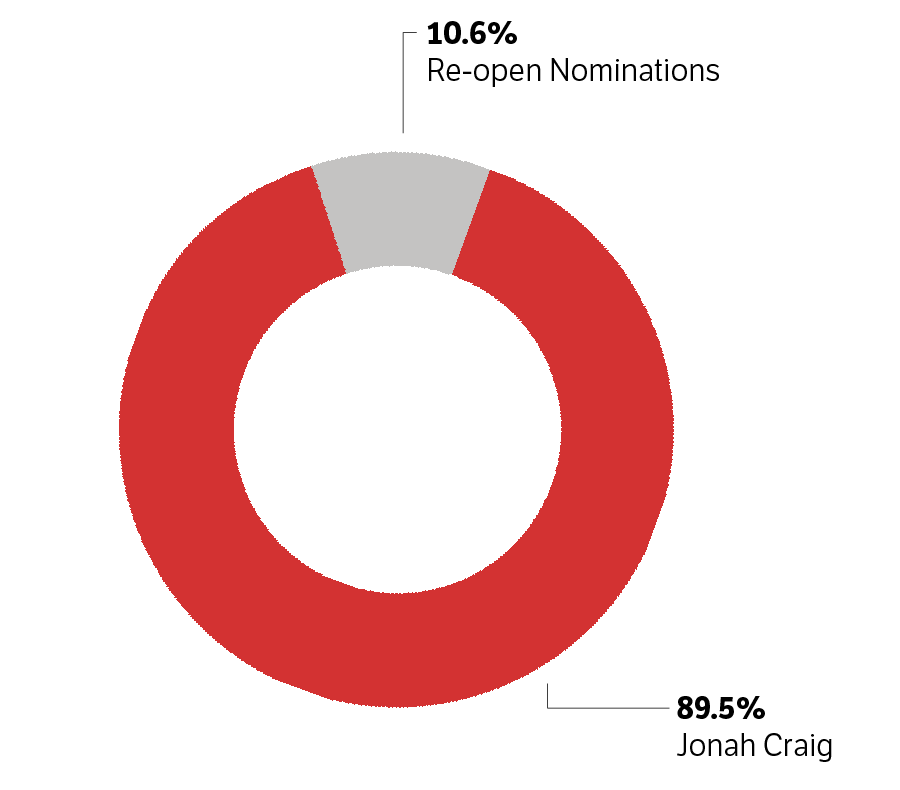
The race that Craig is running differs, of course, to last year’s entertainments officer race. Last year, the student population saw an intense race with four candidates running for the position. Not only did the number of candidates differ but the characteristics of the race were certainly distinctive. We saw two candidates battle, with watermelons and bow ties, for the sabbatical position. Caolan Maher provided some comic relief with the scandalous “can-gate” episode, which saw Maher accused of handing out free cans to students in Halls. The University Times predicted that the entertainments race would go to a third count. However, in a race that was already tight, it proceeded to a fourth count, which saw Rowley elected with 50.6 per cent of the vote and Maher left the race on 38.3 per cent.
Last year, 302 students did not know, at the time they were polled, who they would vote for for the position of entertainments officer. Even with the change in structure of the campaigning and elections period the number of students who did not know, at the end of three days of campaigning, sat at 311 students. It would be expected that, with an uncontested campaign, more of the electorate would decide to be for or against a candidate at an early stage. The data collected by The University Times, however, shows that even with an overwhelming choice of candidates last year students were still more sure of who they would vote for.
Craig, as is the same with the other uncontested candidates, receives the most convinced vote from the health sciences, with only 7.5 per cent of the health science electorate voting to re-open nominations. Craig, in the first week of campaigning, had visited both St James’s and D’Olier St. He visited St James’s on Thursday and then D’Olier St on Friday, during a period in which he was banned from campaigning on campus, in the Arts Block and Hamilton, after being sanctioned for putting two posters on one noticeboard on Thursday. He sees his popularity peak among first-year students, obtaining 92.5 per cent of the vote.
Editor
As a race that is often criticised for being uncontested, it is not surprising that 9.6 per cent of students have chosen to re-open nominations rather than voting for the sole candidate, Dominic McGrath, to be the next Editor of The University Times. McGrath has run an impressive campaign so far, with on-the-ground campaigning being extremely visible, including having visited off-campus locations such as St James’s, D’Olier St and Trinity Hall. This off-campus push appears to be helping with 97 per cent of health science students opting to vote for him rather than re-opening nominations. His online presence has been constant throughout the week. As with the other uncontested candidates, McGrath has spent a lot of his time at hustings alone on stage, but has held his ground even after having come under fire from An Cumann Gaelach, about the small amount of Irish content in the paper, at the equality and diversity hustings on Thursday, February 16th.
McGrath has strongest showing against RON
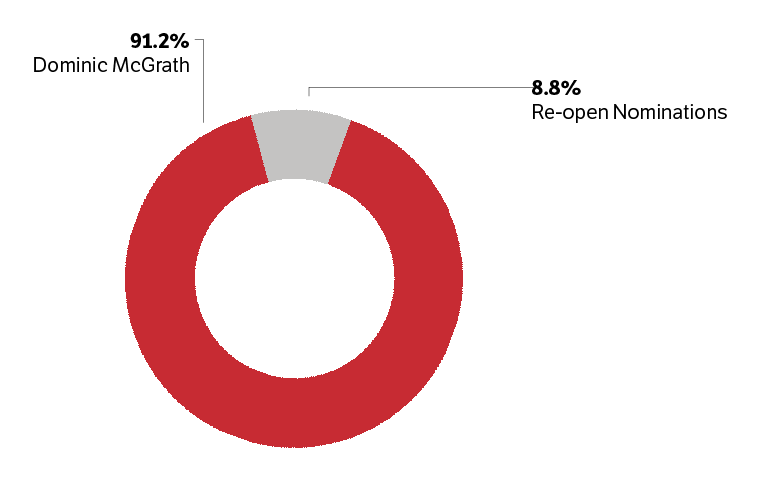
For the past three years, since the paper was removed from the remit of the communications officer, the race to be Editor of The University Times has been uncontested. Although the polls indicate that McGrath will receive less of the vote than his predecessor, Sinéad Baker, this may not necessarily be true. Last year, in a poll of 1,007 students conducted by The University Times, Baker received 91.2 per cent of the vote whereas upon election she only received 84.8 per cent of the vote. The increase in votes for re-open nominations was more than likely due to the general criticism of The University Times’s election coverage last year. McGrath has not been shy of acknowledging that the position has a history of being uncontested. At the media hustings on Wednesday, February 15th, McGrath was asked about the uncontested nature of the race. He responded explaining that this was an “unfair perception”. He put forward the argument that the role of education officer is traditionally uncontested as well. His promises for the paper have been well received and other candidates, Emmet and Keane, have complimented him on his ideas, particularly one that would see secondary school students engaging with journalism through the paper.
Darragh Finn conducted data analysis, cross tabulation and modelling.
Charlotte Ryan, Róisín Power, Jake O’Donnell, Donal MacNamee, Morgan Clarke, John Conway, Ciarán Molloy, Brónagh Kennedy, Rachael Kilduff, Anne Vollertsen, Grace Meagher, Philip McGuinness, James Shaw, Simon Foy and Aoife O’Donoghue conducted polling.
Polling methodology
On Thursday, February 16th and Friday, February 17th, The University Times conducted a poll of 1,005 students in locations on and off campus. Polling was conducted in locations such as the Arts Block, Graduate Memorial Building (GMB), the Hamilton building, Trinity Biomedical Science Institute (TBSI) and St James’s Hospital. Polling was conducted in a manner that sought to represent the predicted size and demographic of the electorate most accurately. In the case of this year’s election, where there are no health science students running, it was found to be most prudent to account for a predicted decrease in turnout amongst health science students while polling. In comparison to the expected turnout of voters, the number of students polled is significantly large. The number of polls conducted results in a margin of error of approximately plus-or-minus three per cent, based on a 95 per cent confidence interval. Pushing the margin of error any lower would require a significant increase in resources that would not alter the outcome of the polls significantly enough to be worthwhile. We would require a much larger sample size in order to achieve minimal saving on error. This is due to the fact that as the number of students polled increases, the decrease of the margin of error lessens. A margin of error in polls is inevitable. However, over the past few years The University Times has predicted the correct outcome of all TCDSU sabbatical elections.






